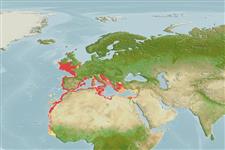Elasmobranchii (haaien en roggen) (sharks and rays) >
Rajiformes (Skates and rays) >
Rajidae (Skates)
Etymology: Raja: Latin, raja, -ae = a sting ray (Raja sp.) (Ref. 45335).
More on author: Lacepède.
Environment: milieu / climate zone / depth range / distribution range
Ecologie
marien demersaal; diepte 50 - 200 m (Ref. 6808). Subtropical; 53°N - 9°N, 19°W - 36°E
Eastern Atlantic: southern Ireland and England to Senegal, including the western Mediterranean and the Canary Islands. Reported from the eastern Mediterranean (Ref. 3261).
Lengte bij maturiteit / Grootte / Gewicht / Leeftijd
Maturity: Lm 80.0 range ? - 85.2 cm
Max length : 100.0 cm TL mannelijk / geslacht onbekend; (Ref. 4426)
Found on sandy bottoms of shelf waters (Ref. 3167). Feed on all kinds of bottom animals (Ref. 3167). Oviparous. Distinct pairing with embrace. Young may tend to follow large objects, such as their mother (Ref. 205). Eggs are oblong capsules with stiff pointed horns at the corners deposited in sandy or muddy flats (Ref. 205). Egg capsules are 7.2-9.0 cm long and 4.2-5.2 cm wide (Ref. 41303 , 41251, 41304).
Oviparous, paired eggs are laid. Embryos feed solely on yolk (Ref. 50449). Egg-cases laid from March to September (Ref. 3167). Distinct pairing with embrace. Young may tend to follow large objects, such as their mother (Ref. 205).
McEachran, J.D. and K.A. Dunn, 1998. Phylogenetic analysis of skates, a morphologically conservative clade of elasmobranchs (Chondrichthyes: Rajidae). Copeia 1998(2):271-290. (Ref. 27314)
Status op de Rode Lijst van het IUCN (Ref. 130435: Version 2024-2)
Gevaar voor de mens
Harmless
Gebruik door de mens
Visserij: commercieel; sportvis: ja
Tools
Speciale rapporten
Download XML
Internetbronnen
Estimates based on models
Preferred temperature (Ref.
123201): 9.8 - 17.1, mean 13.2 °C (based on 157 cells).
Fylogenetische diversiteitsindex (Ref.
82804): PD
50 = 0.5000 [Uniqueness, from 0.5 = low to 2.0 = high].
Bayesian length-weight: a=0.00302 (0.00194 - 0.00469), b=3.19 (3.07 - 3.31), in cm total length, based on LWR estimates for this species & Genus-body shape (Ref.
93245).
Trofisch niveau (Ref.
69278): 3.5 ±0.37 se; based on food items.
Weerstandsvermogen (Ref.
120179): laag, minimale populatieverdubbelingstijd 4,5-14 jaar (Fec assumed to be <100).
Fishing Vulnerability (Ref.
59153): High to very high vulnerability (66 of 100).
Climate Vulnerability (Ref.
125649): Moderate vulnerability (38 of 100).
Nutrients (Ref.
124155): Calcium = 11.4 [1.5, 220.4] mg/100g; Iron = 0.693 [0.064, 8.306] mg/100g; Protein = 17.2 [14.4, 19.5] %; Omega3 = 0.486 [0.222, 1.080] g/100g; Selenium = 28.1 [5.6, 137.4] μg/100g; VitaminA = 4.78 [0.40, 50.57] μg/100g; Zinc = 0.511 [0.033, 5.798] mg/100g (wet weight);
